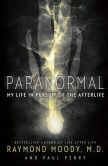Life Beyond Death?
By Raymond Moody, MD, PhD & Paul Perry
HarperOne, 25.99, 256 pages
Unlike Raymond Moody’s wildly popular first book, Life After Life, published in 1975, Moody’s new book, an autobiography, Paranormal: My Life in Pursuit of the Afterlife, begins with his own past life review, and startles the reader by revealing his nearly successful suicide attempt described as, “having the awareness of his dying body,” and the “conscious dimensions of a loving light.”
As a boy, Moody’s sights were on another world as he became hooked on astronomy and dreamed the unimaginable, that one day man would walk on the moon. Moody provides a trajectory that leads him from a philosophy graduate student who explored the inner universe or rather, the outer universe, to the study of Plato and Socrates, and the ancient Greek Oracles where ancient Greeks came to revisit their dead relatives and resolve unfinished issues. Moody was especially influenced by a story in Plato’s Republic, about a soldier named Ur who was thought dead, awakened, and said, “When his soul left the body, he went on a journey with a great company to the underworld,” and reported the, “heavenly delights and visions of inconceivable beauty.” It was then that Moody became fascinated by the Oracle of Delphi and like the ancient Greeks, Moody came to believe that by revisiting one’s dead relatives one can achieve therapeutic results without having to die first to find out. In order to reproduce near-death experiences in people who were not near death, Moody explored the unorthodox world of scrying, an Old English term meaning “to reveal,” through crystal ball gazing, mirror gazing, and water gazing in order to produce a trance like state delivering the initiate through the portal of another world.
Moody eventually builds a psycho-manteum, based on the ancient Greeks Oracle of Delphi, a darkened mirrored room, in order to conduct scientific research on screened subjects.
Moody claims the results of this Psycho-manteum experiment, are an effective means of therapy for grief as well as producing strong enough evidence for the other scientists to pursue the outer regions of the psyche. Although, Moody does not explain how his results could be reproduced scientifically. In the end, Moody says he’s “unsure whether or not life after death is in God’s plan.”
This richly written book is a fascinating read, often confessional, often controversial, but never dull.
Reviewed By Sheila Erwin
[amazon asin=006204642X&text=Buy On Amazon]
[amazon asin=006204642X&text=Buy On Amazon&template=carousel]

